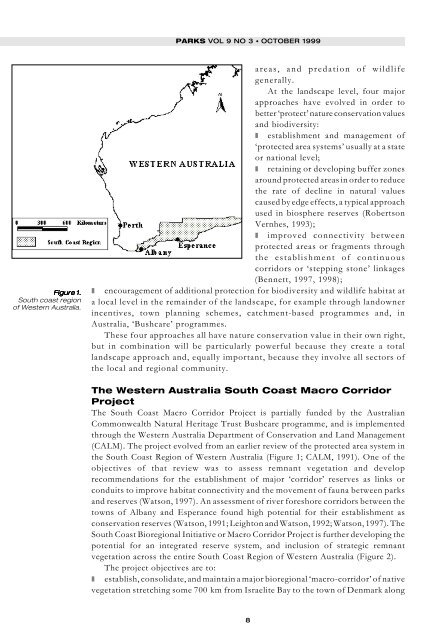Parks - IUCN
Parks - IUCN
Parks - IUCN
You also want an ePaper? Increase the reach of your titles
YUMPU automatically turns print PDFs into web optimized ePapers that Google loves.
Figure Figure Figure Figure Figure 1. 1. 1. 1. 1.<br />
South coast region<br />
of Western Australia.<br />
PARKS VOL 9 NO 3 • OCTOBER 1999<br />
areas, and predation of wildlife<br />
generally.<br />
At the landscape level, four major<br />
approaches have evolved in order to<br />
better ‘protect’ nature conservation values<br />
and biodiversity:<br />
❚ establishment and management of<br />
‘protected area systems’ usually at a state<br />
or national level;<br />
❚ retaining or developing buffer zones<br />
around protected areas in order to reduce<br />
the rate of decline in natural values<br />
caused by edge effects, a typical approach<br />
used in biosphere reserves (Robertson<br />
Vernhes, 1993);<br />
❚ improved connectivity between<br />
protected areas or fragments through<br />
the establishment of continuous<br />
corridors or ‘stepping stone’ linkages<br />
(Bennett, 1997, 1998);<br />
❚ encouragement of additional protection for biodiversity and wildlife habitat at<br />
a local level in the remainder of the landscape, for example through landowner<br />
incentives, town planning schemes, catchment-based programmes and, in<br />
Australia, ‘Bushcare’ programmes.<br />
These four approaches all have nature conservation value in their own right,<br />
but in combination will be particularly powerful because they create a total<br />
landscape approach and, equally important, because they involve all sectors of<br />
the local and regional community.<br />
The Western Australia South Coast Macro Corridor<br />
Project<br />
The South Coast Macro Corridor Project is partially funded by the Australian<br />
Commonwealth Natural Heritage Trust Bushcare programme, and is implemented<br />
through the Western Australia Department of Conservation and Land Management<br />
(CALM). The project evolved from an earlier review of the protected area system in<br />
the South Coast Region of Western Australia (Figure 1; CALM, 1991). One of the<br />
objectives of that review was to assess remnant vegetation and develop<br />
recommendations for the establishment of major ‘corridor’ reserves as links or<br />
conduits to improve habitat connectivity and the movement of fauna between parks<br />
and reserves (Watson, 1997). An assessment of river foreshore corridors between the<br />
towns of Albany and Esperance found high potential for their establishment as<br />
conservation reserves (Watson, 1991; Leighton and Watson, 1992; Watson, 1997). The<br />
South Coast Bioregional Initiative or Macro Corridor Project is further developing the<br />
potential for an integrated reserve system, and inclusion of strategic remnant<br />
vegetation across the entire South Coast Region of Western Australia (Figure 2).<br />
The project objectives are to:<br />
❚ establish, consolidate, and maintain a major bioregional ‘macro-corridor’ of native<br />
vegetation stretching some 700 km from Israelite Bay to the town of Denmark along<br />
8

















